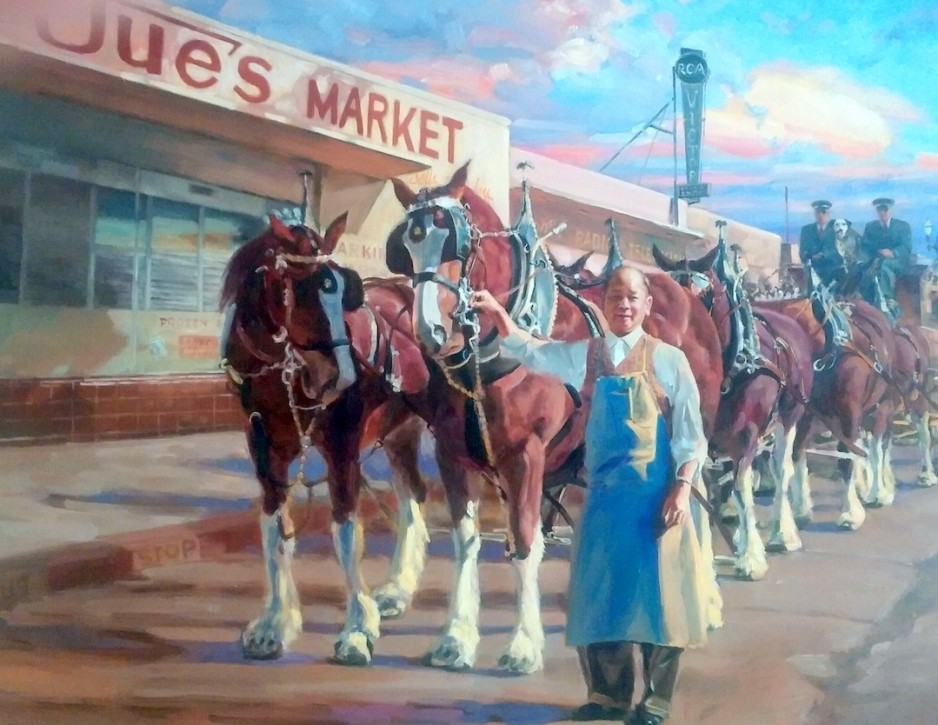Painting of Walton Jue from an historical photograph painted by Pang Qi the artist of the Chinese mural on Figueroa Street.
by Karen Helen Szatkowski
Even before California incorporated San Buenaventura as a city in 1866, immigrants from foreign lands decided this was a worthy landing to improve their lives and prospects. The first early years in the mid-19th Century saw single men and whole families arriving from the Pearl River Delta in Southeast China. They were escaping wars, hunger, chaos and death. They came with all their resources and sought employment and survival.
Progress was popping in Ventura by 1860 and the town and environs needed workers. The Chinese migrants arrived with their farming skills and found initial employment in the fields. Chinese laborers also built a water canal for Ventura and worked in construction all over town. Chinese owned businesses sprung up as well. Figueroa Street from Santa Clara to Main Street was an active part of the Mission area scene and possibly 200 people lived in this one block along with small livestock and their own firehouse.
In 1905 the street was sold to development and the Chinese were made to find new land for homes and businesses. Anti-Chinese animosity was building and a federal law barred further immigration after 1882 with only few exceptions. Ventura was not immune to this animosity with accusations that the Chinese were driving down the wages of American workers. A Chinese Rights Organization fought such injustice as well as the claim by some that the Chinese would not assimilate and they were carrying disease. By 1920 the second Chinese community’s land was sold by the last landowning Chinese family and the demise of China Town Ventura was fully realized.
Fast forward from those years to the next generation of Chinese immigrants which arrived in the persons of Walton and Bob Jue. After a few years in the central valley an opportunity blossomed via a letter from a landowner in Ventura and they opened a grocery across from the Mission in 1927 and a real Jue dynasty was born. Hailing from the Hoiping area of China many of the clan developed in businesses and farming throughout the county. Walton’s wife, Mary, was finally allowed a visit to the United States, she remained and the two eventually had five children together.
By the late years of the 1920s and 1930s the animosity towards the Chinese diminished somewhat and Walton Jue and his family were welcomed as successful business owners and good neighbors. In 1946 Walton moved his store to bigger quarters at the corner of Santa Cruz and Main Street and Walton had his Grand Opening on a Thursday in September of that year because Friday was the 13th; not a man to tempt fate. The store meant many things to the city, not the least of which was the opportunity for part time work for teens in the neighborhood. To paraphrase first born daughter Dorothy Jue Lee: They could learn some financial responsibility and sharpen their math skills to boot.
Jue’s Market was the second grocery in Ventura after Peirano’s and became a veritable landmark. The annual fair parade was a real event at the store and the accompanying picture shows Walton with the Budweiser Clydesdales sometime during the 1950s. Jue’s Market business was sold in 2001 after all the decades of serving farmers, customers and the city itself. The Jue family and the branches brought forth from that original root have accomplished many successes in academics and business and have earned friendship and respect from the city and beyond.
The Ventura County Historical Society has published a journal by Linda Bentz with far more detailed and interesting information which can be found in the Ventura County Museum’s library on Main Street across from the Mission where, coincidentally, Ventura’s China Town was and the original market was opened by the Jue Brothers.

